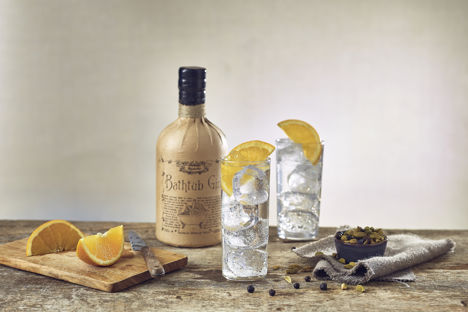
Bathtub Gin: a gin for lovers of flavour
Since it first appeared on the scene in 2011, Bathtub Gin has consistently scooped awards around the world, confirming its place as one of the best gins for lovers of flavour everywhere. We take a closer look at what makes this British-made gin so special.
Bathtub Gin: a gin for lovers of flavour
Since it first appeared on the scene in 2011, Bathtub Gin has consistently scooped awards around the world, confirming its place as one of the best gins for lovers of flavour everywhere. We take a closer look at what makes this British-made gin so special.
The rise of craft gin in the UK has been a wonderful thing to witness. Walk through the aisles of your local supermarket today and you’ll see shelves dedicated to a still-rising swell of British gins, all boasting their own unique flavour characteristics and stories. But with so many to choose from, where do you start if you’re looking for a good bottle of gin?
The new wave of craft gins are all made using different methods and have vastly different spectrums of flavour and aroma. It’s tough for a gin to stand out among the crowd these days, but Bathtub Gin, with its unique production method and iconic paper packaging, has been a consistent top performer of the gin-aissance. Since arriving on shelves in 2011, Bathtub Gin has scooped dozens of medals including gold medals over multiple years at the International Wine & Spirit Competition, the World Gin Awards and the Gin Masters.
Bathtub Gin was founded in 2011 by three friends who set out to create a bolder and more vibrant tasting gin than any other. In the pursuit of their goal they turned to the history books and that’s where they came across a long-forgotten technique that would ultimately inspire Bathtub Gin. The name itself harks back to the prohibition-era United States, where would-be gin makers without access to a distillery learned that they could cold infuse botanicals into spirits to create ‘bathtub gins’. This technique was often used to cover up the flavour of poor quality neutral grain spirit and thus it fell out of favour, but Bathtub Gin’s innovation is that it combines this method with the best modern gin-making techniques in a two-step production process. The result? A gin super-charged with fresh botanical flavour.
Bathtub Gin uses a clever double infusion technique to separate itself from the pack. Most gins these days are infused through distillation, whereby the botanicals are added whilst the alcohol is distilled. Bathtub Gin, however, is made by a two-stage process. They begin by distilling a traditional London Dry Gin with juniper, coriander and other fragrant botanicals in a copper-pot still, then they add an additional six botanicals and allow these to infuse into the gin over the course of another week. Distillation, while effective, is also a bit of a brute when it comes to infusing flavour, using heat to enact the chemistry. Bathtub Gin’s secondary infusion process without the application of heat allows the infusion of delicate flavours that would be all but destroyed by distillation. Imagine biting into a fresh strawberry, versus strawberry jam.
This double infusion technique doesn’t just add extra flavour to the gin, it also lends a pleasant viscosity and a slight botanical hue to the resulting spirit. Bathtub Gin gives a strong sense of juniper on the nose and on the palate, but that gives way to exotic spices like cardamom, cinnamon, and a long, pleasant finish of orange peel and orange blossom.
The complex flavour profile of something like Bathtub Gin makes a wonderful gin and tonic, especially when served with lots of ice and a slice of orange (orange is used in both stages of the double infusion process), but the richness of the aromatics also makes it a fantastic all-rounder. You can enjoy it in a number of cocktails – its big flavour profile means it is able to stand up to other strong cocktail ingredients. For example, it makes an exceptionally fine negroni (try the Rosé negroni below to see what we mean).
Bathtub Gin is a rather larger operation than it was a few years ago, but there’s something very comforting about knowing that every bottle is still hand-wrapped in brown paper, dipped in wax and tied up with string in Kent, where it all started.


